
10 minute read
Result of FCA’s Business Interruption test case
THE HIGH COURT HAS TODAY HANDED DOWN ITS JUDGMENT IN THE FINANCIAL CONDUCT AUTHORITY’S (FCA)’S BUSINESS INTERRUPTION INSURANCE TEST CASE.
The Court found in favour of the arguments advanced for policyholders by the FCA on the majority of the key issues.
Christopher Woolard, Interim Chief Executive of the FCA, commented: ‘We brought the test case in order to resolve the lack of clarity and certainty that existed for many policyholders making business interruption claims and the wider market. We are pleased that the Court has substantially found in favour of the arguments we presented on the majority of the key issues. Today’s judgment is a significant step in resolving the uncertainty being faced by policyholders. We are grateful to the court for delivering the judgment quickly and the speed with which it was reached reflects well on all parties.
‘Coronavirus is causing substantial loss and distress to businesses and many are under immense financial strain to stay afloat. Our aim throughout this court action has been to get clarity for as wide a range of parties as possible, as quickly as possible and today’s judgment removes a large number of those roadblocks to successful claims, as well as clarifying those that may not be successful.
‘Insurers should reflect on the clarity provided here and, irrespective of any possible appeals, consider the steps they can take now to progress claims of the type that the judgment says should be paid. They should also communicate directly and quickly with policyholders who have made claims affected by the judgment to explain next steps.
‘If any parties do appeal the judgment, we would expect that to be done in as rapid a manner as possible in line with the agreement that we made with insurers at the start of this process. As we have recognised from the start of this case, thousands of small firms and potentially hundreds of thousands of jobs are relying on this.’ BACKGROUND Many policyholders whose businesses were affected by the Covid-19 pandemic suffered significant losses, resulting in large numbers of claims under business interruption (BI) policies.
Most SME policies are focused on property damage and only have basic cover for BI as a consequence of property damage. But some policies also cover for BI from other causes, in particular infectious or notifiable diseases (‘disease clauses’) and non-damage denial of access and public authority closures or restrictions (‘denial of access clauses’). In some cases, insurers have accepted liability under these policies. In other cases, insurers have disputed liability while policyholders considered that it existed, leading to widespread concern about the lack of clarity and certainty.
The FCA’s aim in bringing the test case was to urgently clarify key issues of contractual uncertainty for as many policyholders and insurers as possible. The FCA did this by selecting a representative sample of policy wordings issued by eight insurers. The FCA’s role was to put forward policyholders’ arguments to their best advantage in the public interest. 370,000 policyholders were identified as holding policies that may be affected by the outcome of the test case.
WHAT TODAY’S JUDGMENT DECIDES The judgment is complex, runs to over 150 pages and deals with many issues. A summary of the key points are below. The FCA’s legal team at Herbert Smith Freehills have published a summary on their website, which may be referred to for further detail.
In order to establish liability under the representative sample of policy wordings, the FCA argued for policyholders that the ‘disease’ and/or ‘denial of access’ clauses in the representative sample of policy wordings provide cover in the circumstances of the Covid-19 pandemic, and that the trigger for cover caused policyholders’ losses.
The judgment says that most, but not all, of the disease clauses in the sample provide cover. It also says that certain denial of access clauses in the sample provide cover, but this depends on the detailed wording of the clause and how the business was affected by the Government response to the pandemic, including for example whether the business was subject to a mandatory closure order and whether the business was ordered to close completely.
The test case has also clarified that the Covid-19 pandemic and the Government and public response were a single cause of the covered loss, which is a key requirement for claims to be paid even if the policy provides cover. WHAT TODAY’S JUDGMENT MEANS FOR POLICYHOLDERS Although the judgment will bring welcome news for many policyholders, the judgment did not say that the eight defendant insurers are liable across all of the 21 different types of policy wording in the representative sample considered by the Court. Each policy needs to be considered against the detailed judgment to work out what it means for that policy. Policyholders with affected claims can expect to hear from their insurer within the next 7 days.
The test case has removed the need for policyholders to resolve a number of the key issues individually with their insurers. It enabled them to benefit from the expert legal team assembled by the FCA, providing a comparatively quick and cost-effective solution to the legal uncertainty in the business interruption insurance market.
The test case was not intended to encompass all possible disputes, but to resolve some key contractual uncertainties and ‘causation’ issues to provide clarity for policyholders and insurers. The judgment does not determine how much is payable under individual policies, but will provide much of the basis for doing so.
It is possible that the judgment will be appealed. Any appeal does not preclude policyholders seeking to settle their claims with their insurer before the outcome of any appeal is known.
It is important that policyholders, action groups, insurance intermediaries and their legal representatives are properly engaged throughout the test case process. The FCA has therefore arranged an opportunity for them to talk to its legal team individually on Monday 21 September or Tuesday 22 September - find out more.
NEXT STEPS The FCA and Defendant insurers are considering the judgment and what it might mean in respect of any appeal. Any applications to appeal will be heard at a consequentials hearing before the High Court. The FCA is seeking to have a consequentials hearing as early as possible.
The FCA and Defendant insurers have agreed that they will seek to have any appeal heard on an expedited basis, given the importance of the matter for so many policyholders. This includes exploring the possibility of any appeal being a ‘leapfrog’ appeal to the Supreme Court (rather than needing to be heard by the Court of Appeal first).
The FCA will continue to keep policyholders appraised of matters as they progress, through its dedicated webpage: www.fca.org.uk/firms/businessinterruption-insurance
CONSTRUCTION OF THE MINI FR II APPLIANCE
By Kerry Lancaster, Chief Instructor Orthodontic Technician, Eastman Dental Institute, UCL
The Mini FR II is a variation of the Frankel II appliance, with the main difference being the wire gauges are bigger and the Lingual hanger design is different to the original. The advantage of the Mini FR II is that it can be advanced in cases where the overjet is large and may have to be reduced in a two phased approach.

This appliance is used in Class 11 Division I occlusions with deep and complete overbites. METHOD OF CONSTRUCTION Impressions should provide good reproduction of the sulcal region.
Once the models have been cast make sure not to lose detail of the sulcal region when trimming as this helps with the construction of accurately fitting shields. The models are then articulated on a plane line articulator, using the functional bite supplied with the impressions.
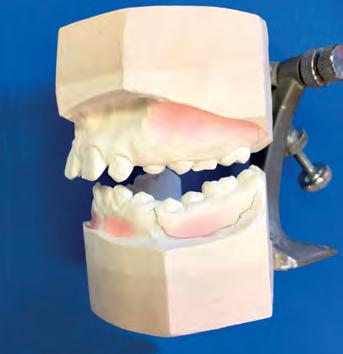
Make sure the arms of the articulator are parallel and greased with Vaseline.
The models need to be left a while to dry out before surveying to determine the most severe undercuts.
A light wash of wax is applied to block out the most severe undercuts. If this is not done then the appliance may not easily be inserted or removed from the mouth.
Spacing is applied using wax to upper and lower buccal regions to facilitate buccal movement of upper buccal segments and minimised buccal movement of lower buccal segments;

COMPONENT PARTS OF THE MINI FR II
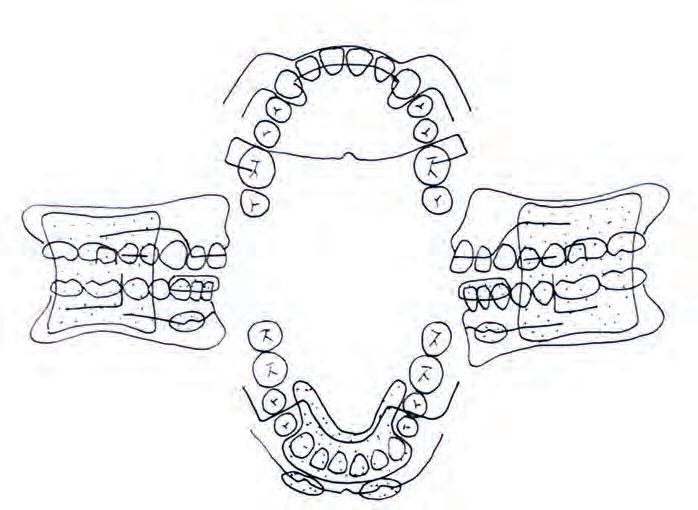
Upper: 2 thicknesses of wax applied to buccal surface of teeth, thinning to 1 thickness of wax onto gingival/sulcal region. Lower: 1 thickness of wax applied to buccal surface of teeth, thinning to a light wash onto gingival/sulcal region
Construct the wire work for the lower and secure in place before applying the acrylic. The lower model can either be soaked in water or a separating medium applied.
NB: the upper and lower wirework must allow 1mm of space from wax spacing to allow good acrylic encapsulation. Do not allow more than 1mm space as this will increase the thickness of the acrylic shields and therefore make it uncomfortable to wear which could result in non-compliance.
Lingual Hanger, 1.5mm wire is adapted just below lingual gingival margin and bent up in pre molar region crossing midway between the upper and lower teeth. It is then bent at 90 degrees and cut just short of distal of 6’s. Make sure that both sides are parallel to facilitate advancement where necessary.
Pellotte wire, 0.9mm is adapted in labial sulcal region with off-set bends to aid mechanical retention within the acrylic. The wire ends are encapsulated in the acrylic shields and finish just short of the lingual hanger.
WHILST THE ACRYLIC IS CURING, CONSTRUCTION CAN BEGIN ON THE UPPER MODEL.
Transpalatal wire, 1.25mm sits with 1.5-2.0mm space from the palate, incorporating a loop to give flexibility. The wires cross the occlusion mesial of the 6’s. It’s important that the wire is in contact with the mesial of the 6’s as this will allow Class II traction force. The wires are then bent at 90 degrees and back through onto occlusion of 6’s allowing 1mm of space for eruption.
Palatal bow, 1.0mm is adapted to palatal surface of incisors in an ideal arch with U loops spaced 1mm from the palate. The wires cross the occlusion contacting mesial to the pre-molars.
Labial bow, 1.0mm is adapted in an ideal arch to contact the labial surface of upper incisors, it then sweeps up beyond the margins and downwards into buccal region.
The acrylated lingual hanger and pellotte wire are trimmed to size, pumiced and polished. Make sure the wax spacing is smooth before securing all the upper and lower wirework.
The space between the upper and lower arches is filled in with wax and wax shuttering is placed at the mesial and distal borders of the shields.
NB: it is worth covering the lower acrylic with wax to protect it whilst applying acrylic shields.
Cold cure Acrylic is applied, being careful to ensure that the wirework is completely encapsulated.
The shields are then trimmed to size and shape ensuring that they are not too thick and there are no rough or sharp areas on the borders that could
cause trauma. u
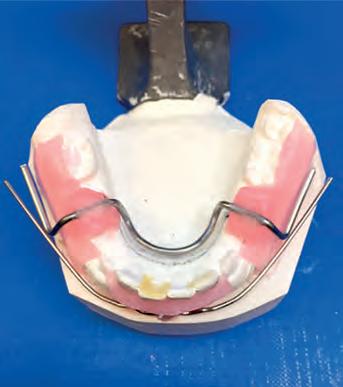
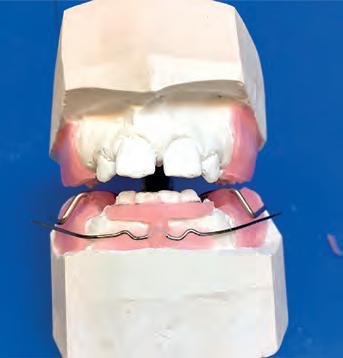






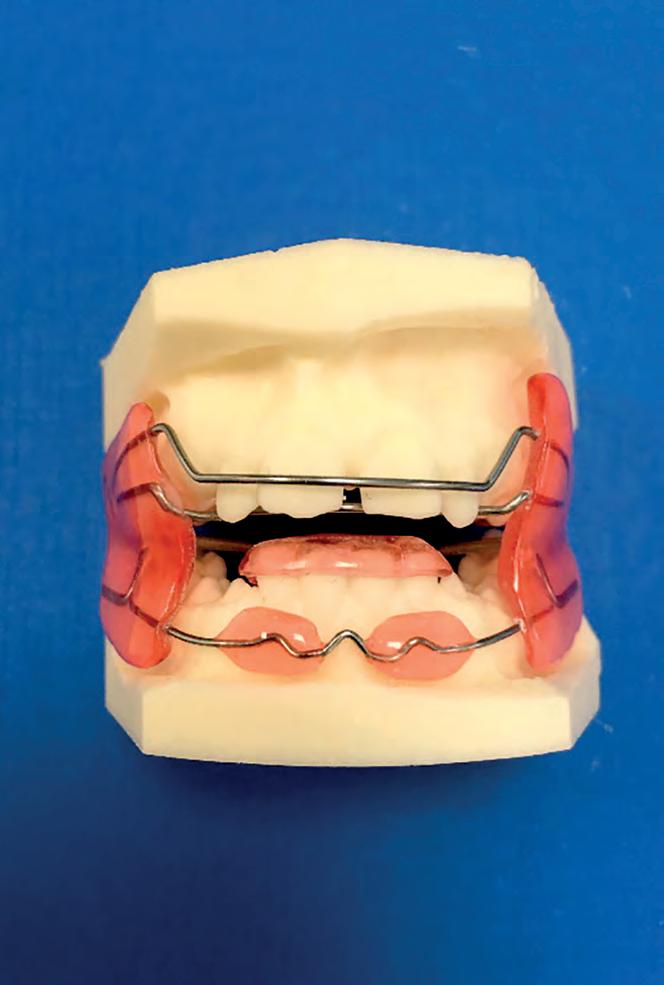


THE FINISHED APPLIANCE
ADVANCEMENT OF MINI FR II
Vertical and horizontal cuts are made as shown. The section is then advanced by the required amount. The gap is filled with new acrylic.
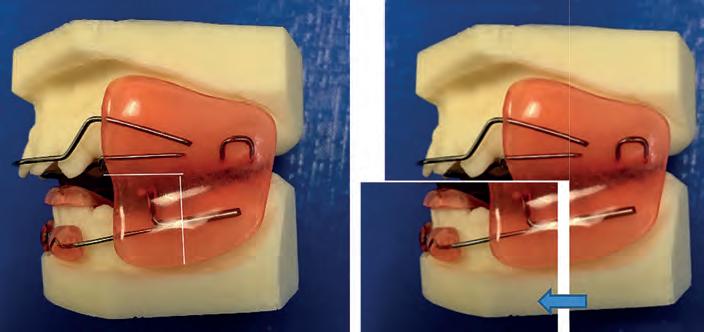
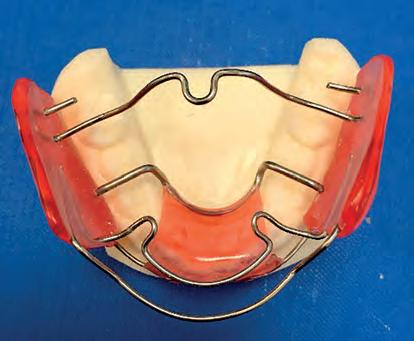
MATERIALS: Crystacal R stone, K.C Smith stainless steel wire, Leocryl cold cure acrylic
ACKNOWLEDGEMENTS: Mr Vaughan Jones, Mr Ed Payne, Mr Joseph Noar
REFERENCES: Functional appliances in orthodontic treatment: an atlas of clinical prescription and laboratory construction HS Orton - 1990 - Quintessence Publishing (IL) The treatment of Class II, Division 1 malocclusion with functional correctors R. Fränkel - Am. J. Orthod., 55 (1969), pp. 265-275 A functional approach to orofacial orthopaedics Frankel, R. (1980) - British Journal of Orthodontics, 7, 41–51.









